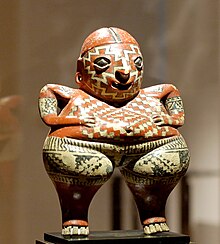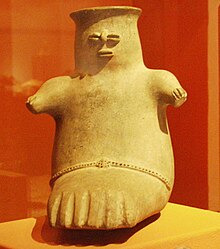Chupícuaro culture

The Chupícuaro culture is named after the place of the same name in the central Mexican state of Guanajuato . However, some researchers also assign finds from other highland regions of Mexico to this culture.
location
The small town of Chupícuaro is located about 160 km (as the crow flies) northwest of Mexico City and about twelve kilometers east of the city of Acámbaro in the south of the state of Guanajuato at an altitude of about 1850 m above sea level. d. M.
Living conditions
In view of the lack of written sources, there is little reliable knowledge about the living conditions and social structure of the people of the Chupícuaro culture. However, it can be assumed that they were small village companies that farmed in the valley of the Río Lerma and cultivated maize, beans, chilli etc. and supplemented their protein requirements with hunting and fishing. Stone temples or even houses were unknown and people lived in reed huts reinforced with wooden poles.
Dating
There is no clarity regarding the dating of the finds. While some researchers favor older dates, most archaeologists currently believe that the figurines date back to 600 BC. And 250 AD, with some archaeological research (or the art market) believing to have recognized three phases: an older monochrome phase (approx. 600–400 BC), a middle geometrical- polychrome (approx. 400–100 BC) and a late phase (approx. 100 BC to approx. 250 AD), in which most of the unpainted and unpolished small figurines are said to have been created. In the period after 250 AD no more grave goods were made from clay - it is unknown whether grave goods (e.g. in the form of wooden objects, shells, etc.) were still buried.
Grave goods
All finds discovered so far were specially made as grave goods and - mostly during robbery excavations since the 1940s - found in the above-ground imperceptible graves in the area of Chupícuaro; they were sold on the black market and ended up in private collections, from where they gradually find their way into museums via the art market or through donations. Due to their very simple design, modern counterfeits cannot be ruled out. In addition to the vessels and figurines, knives and scrapers made of obsidian , miniature rubbing stones ( metates ) as well as jewelry made of pearls, shells etc. were found in the graves.
So far, around 400 individual graves have been investigated, in which dog skeletons were sometimes found, which could point to the function of the dog as a loyal companion of humans - also known in the American Indian cultures; but dogs were also eaten in America and so the four-legged friends who were buried could have been a symbolic food reserve for the other world.
Found objects

According to purely formal criteria, three types can be distinguished: vessels, medium-sized (height 20–50 cm) fully plastic, hollow figures inside and small (height 5–15 cm) modeled figurines with attached faces; There are also mixed forms between the vessels and the round three-dimensional figures. What the first two types have in common is the smoothly polished surface, often with a geometric painting, which formerly - like any form of (body) jewelry - certainly had an ominous ( apotropaic ) meaning. The faces of the third type look like they have been glued on - body and / or face painting is missing, instead the figures wear necklaces, earrings, elaborate hairstyles and turban-like headgear. The missing or often very rudimentary representation of the limbs is also striking. Most of the characters are obviously female. However, it is questionable whether this allows conclusions to be drawn about a socially prominent role of women. Some of the female figurines are also referred to as goddesses - but without giving reasons.
Although hunting and fishing as well as domestic animals (dogs, turkeys ) probably played an important role in the nutrition of the people, no depictions of wild or domestic animals are known.
See also
literature
- Dolores Flores: Ofrendas Funerarias de Chupícuaro Guanajuato. INAH, 1992.
- Ana María Crespo: La arqueología en Guanajuato. INAH, 1988.
Web links
- Chupícuaro, figural vase - Photo + info (English)
- Chupícuaro culture, 2 figurines - photos + information (English)
- Chupícuaro culture, 6 painted bowls a. Jugs - photos
- Chupícuaro culture, small statuettes etc. - photos
- Chupícuaro culture, statuette - photo
Coordinates: 20 ° 1 ′ N , 100 ° 35 ′ W
